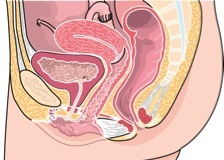-
Women’s Health Issues






Pelvic Inflammatory Disease (PID)
Pelvic inflammatory disease (PID) is an infection that goes up through the uterus to the fallopian tubes. Both females and males carry the organisms that cause PID. These can be passed on to someone else who could then develop PID. This occurs even when no symptoms are noticed.
Signs & Symptoms
Symptoms of Acute PID
-
•Pain in the abdomen or back. The pain can be severe.
-
•Vaginal discharge with a foul odor.
-
•Pain during sex.
-
•The abdomen is tender and/or bloated.
-
•Menstrual cramps are very painful.
-
•High fever.
Symptoms of Chronic PID
-
•Pain in the abdomen or back is less severe. This often occurs midway in the menstrual cycle or during a pelvic exam.
-
•Skin on the abdomen is sensitive.
-
•Vaginal discharge. Change in menstrual flow.
-
•Nausea.
-
•Low-grade fever.
Causes
-
•Sexually transmitted infections (STIs), such as gonorrhea and chlamydia. The organisms that cause these spread to the internal reproductive organs. Many times, PID is caused by more than one of these organisms.
-
•Bacteria normally found in the intestines can get into the pelvic cavity. Times this can happen:
-
-After sex, especially having vaginal intercourse right after having anal sex.
-
-With high risk sexual practices that increase the risk of infection. Examples are having many sex partners or having sex with a person who has many partners.
-
-After an intrauterine device (IUD) is put in or adjusted.
-
•Having had PID in the past.
-
•Recently having vaginitis.
Treatment
Antibiotics treat diagnosed PID. Treatment for an infected sex partner is also needed. This prevents getting the infection again. When PID is not treated, the infection can spread to other parts of the body. If it spreads to the blood, it may threaten life. Scarring from the infection can damage a woman’s reproductive organs. It can cause infertility. Also, a woman who has had PID is at increased risk for:
-
•A tubal pregnancy.
-
•Premature labor and birth.

Female Reproductive System








Self-Care / Prevention
-
•Wipe from front to back after a bowel movement. This helps to keep bacteria from getting into the vagina.
-
•When you menstruate, change tampons and/or pads often.
-
•Don’t have vaginal sex right after anal sex.
-
•Don’t have sex with anyone who has not been treated for a current case of PID or an STI. Don’t have sex with anyone who has partners that haven’t been treated.
-
•Use barrier birth control methods with spermicides. These reduce the risk of getting PID from an infected partner. Use a male or female condom, the cervical cap, or a diaphragm. Use one of these, even if you use other forms of birth control, such as the pill.
-
•Don’t use an IUD if you are at risk for STIs.
-
•If you use an IUD, have your doctor remove it if you get pregnant and then miscarry. If it is left in, your risk of PID goes up.
-
•Don’t smoke. Smoking 10 or more cigarettes a day puts you at a higher risk for PID.
-
•Don’t use douches. These can spread bacteria further up the vagina.
-
•After childbirth, wait until you stop bleeding to have sex. After a D & C, abortion, or miscarriage, wait 1 week to have sex. Use a latex or polyurethane condom for 2 weeks after having an IUD put in.
-
•If you are at risk for PID, get tested for chlamydia and gonorrhea every 6 months.
Have you had unprotected sex with someone who has or might have a sexually transmitted infection?
Have you had an IUD put in and does it cause discomfort?
Do you have signs and symptoms of acute or chronic PID listed on this page?
Do you have very severe pain?
Questions to Ask



Get more information from:
National Women’s Health Information Center | 800.994.9662 | www.womenshealth.gov




Copyright © 2009, American Institute for Preventive Medicine. All rights reserved.